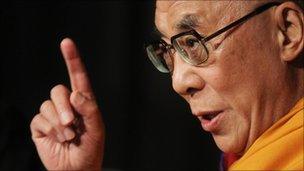Profile: The Dalai Lama
- Published

The Dalai Lama has worked to preserve Tibetan culture and identity
In March 1959, as Chinese troops crushed an attempted uprising in Tibet, Tenzin Gyatso, the 14th Dalai Lama, fled into India.
Then a young man in his mid-20s, the future must have seemed bleak.
With few countries prepared to respond to China's actions, he faced a difficult task to protect Tibetans and their traditions.
Yet despite 50 years in exile, the reach of Tibet's spiritual leader has extended far beyond his community and he is now recognised as one of the world's leading religious figures.
He was awarded the Nobel Peace Prize in 1989 for his consistent opposition to the use of violence in his quest for Tibetan self-rule.
But Beijing continues to view him as a "splittist", although he has repeatedly stated that his goal is for Tibetan autonomy rather than independence.
Child leader
The 14th Dalai Lama was born on 6 July 1935, in a small village just outside the current boundaries of Tibet.
His parents, who named him Lhamo Dhondub, were farmers with several other children.
When he was two years old, a search party of Buddhist officials recognised him as the reincarnation of the 13 previous Dalai Lamas and he was enthroned before he turned four.
He was educated at a monastery and went on to achieve the Geshe Lharampa Degree, a doctorate of Buddhist philosophy.
But in 1950, when he was 15, the troops of Mao Tse-tung's newly-installed Communist government marched into Tibet.
As soldiers poured into the country, the Dalai Lama - his title means Ocean of Wisdom - assumed full power as head of state.
In May 1951, China drew up a 17-point agreement legitimising Tibet's incorporation into China.
When Tibetans took to the streets in 1959 demanding an end to Chinese rule, troops crushed the revolt and thousands of protesters were killed.
The Dalai Lama fled to India on foot and settled in Dharamsala, in the north of the country, which is now home to the Tibetan government-in-exile.
He was followed into exile by about 80,000 Tibetans, most of whom settled in the same area.
'Middle way'
In exile, the Dalai Lama began the task of trying to preserve the culture of the Tibetan people and publicise their plight on the world stage.
He appealed to the United Nations and persuaded the General Assembly to adopt resolutions in 1959, 1961 and 1965 calling for the protection of the Tibetan people.
The Dalai Lama has met leaders throughout the world during his exile
He has met political and religious leaders throughout the world and visited the late Pope John Paul II on several occasions.
The Dalai Lama has advocated a "middle way" to resolve the status of Tibet - genuine self-rule for Tibet within China.
In 1987, amid protests in Lhasa against the large-scale relocation of Han Chinese into Tibet, the Dalai Lama proposed a five-point plan, in which he called for the establishment of Tibet as a zone of peace.
But he did not move from his stance of peaceful resistance and in 1989 was awarded the Nobel Peace Prize.
The committee praised his policy of non-violence, which it called "all the more remarkable when it is considered in relation to the sufferings inflicted on the Tibetan people".
New challenges
Despite their disagreements, the Dalai Lama has continued to seek dialogue with Beijing. Talks between the two sides broke down in 1993 and there were no more for nearly a decade.
Discussions resumed in 2002 and have continued intermittently but with no apparent progress.
Tensions between China and the Tibetan government-in-exile worsened in the wake of unrest in Tibet in March 2008 - the worst for 20 years.
Protests sparked by the anniversary of the 1959 uprising turned into riots on the streets of Lhasa. Violent protests were also reported among Tibetan communities in neighbouring regions.
China says at least 18 people were killed by rioters. Tibetan groups say as many as 200 people died in a crackdown by Chinese security forces.
The Dalai Lama is also facing challenges within the exile community.
Some young Tibetan activists believe pacificism does not work and, although most approve of the Dalai Lama's leadership, a growing number are calling for a tougher line.
There is also growing concern over who will leader the Tibetan movement in the future.
In March 2011, the Dalai Lama said that he planned to hand his political responsibilities to an elected representative, saying such a move was in the best interests of the Tibetan people.
"My desire to devolve authority has nothing to do with a wish to shirk responsibility," he said. "It is to benefit Tibetans in the long run. It is not because I feel disheartened."
"Tibetans have placed such faith and trust in me that as one among them I am committed to playing my part in the just cause of Tibet."